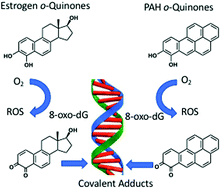当前位置:
X-MOL 学术
›
Toxicol. Res.
›
论文详情
Our official English website, www.x-mol.net, welcomes your
feedback! (Note: you will need to create a separate account there.)
Genotoxicity of ortho-quinones: reactive oxygen species versus covalent modification
Toxicology Research ( IF 2.2 ) Pub Date : 2017-09-06 00:00:00 , DOI: 10.1039/c7tx00223h Trevor M. Penning 1, 2, 3, 4
Toxicology Research ( IF 2.2 ) Pub Date : 2017-09-06 00:00:00 , DOI: 10.1039/c7tx00223h Trevor M. Penning 1, 2, 3, 4
Affiliation

|
o-Quinones are formed metabolically from natural and synthetic estrogens as well as upon exposure to polycyclic aromatic hydrocarbons (PAH) and contribute to estrogen and PAH carcinogenesis by genotoxic mechanisms. These mechanisms include the production of reactive oxygen species to produce DNA strand breaks and oxidatively damaged nucleobases; and the formation of covalent depurinating and stable DNA adducts. Unrepaired DNA-lesions can lead to mutation in critical growth control genes and cellular transformation. The genotoxicity of the o-quinones is exacerbated by nuclear translocation of estrogen o-quinones by the estrogen receptor and by the nuclear translocation of PAH o-quinones by the aryl hydrocarbon receptor. The properties of o-quinones, their formation and detoxication mechanisms, quinone-mediated DNA lesions and their mutagenic properties support an important role in hormonal and chemical carcinogenesis.
中文翻译:

遗传毒性邻-quinones:活性氧对共价修饰
邻奎宁类由天然和合成雌激素代谢形成,以及暴露于多环芳烃(PAH)时形成,并通过基因毒性机制促进雌激素和PAH的致癌作用。这些机制包括产生活性氧以产生DNA链断裂和氧化损伤的核碱基。并形成共价的脱嘌呤和稳定的DNA加合物。未修复的DNA损伤会导致关键的生长控制基因突变和细胞转化。雌激素受体使雌激素邻醌发生核易位,芳基烃受体使PAH邻醌发生核易位,加剧了邻醌的遗传毒性。的性质邻醌,它们的形成和解毒机理,醌介导的DNA损伤及其诱变特性支持激素和化学致癌作用中的重要作用。
更新日期:2017-09-13
中文翻译:

遗传毒性邻-quinones:活性氧对共价修饰
邻奎宁类由天然和合成雌激素代谢形成,以及暴露于多环芳烃(PAH)时形成,并通过基因毒性机制促进雌激素和PAH的致癌作用。这些机制包括产生活性氧以产生DNA链断裂和氧化损伤的核碱基。并形成共价的脱嘌呤和稳定的DNA加合物。未修复的DNA损伤会导致关键的生长控制基因突变和细胞转化。雌激素受体使雌激素邻醌发生核易位,芳基烃受体使PAH邻醌发生核易位,加剧了邻醌的遗传毒性。的性质邻醌,它们的形成和解毒机理,醌介导的DNA损伤及其诱变特性支持激素和化学致癌作用中的重要作用。











































 京公网安备 11010802027423号
京公网安备 11010802027423号